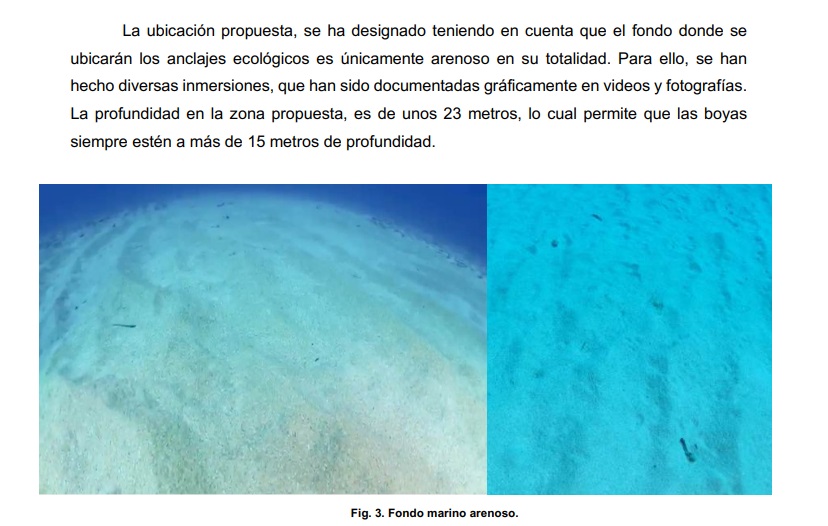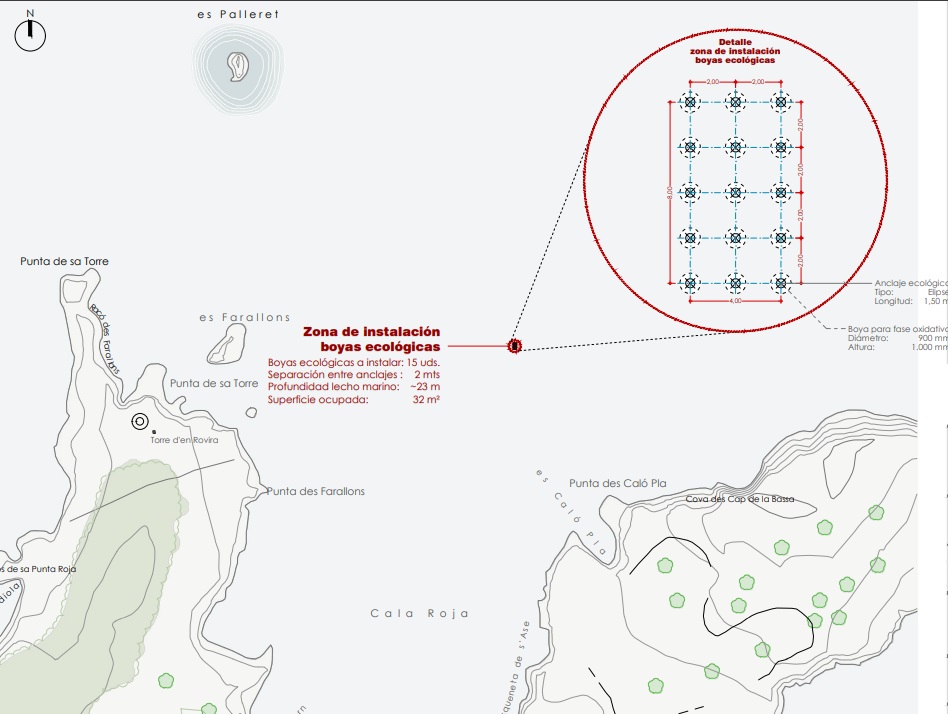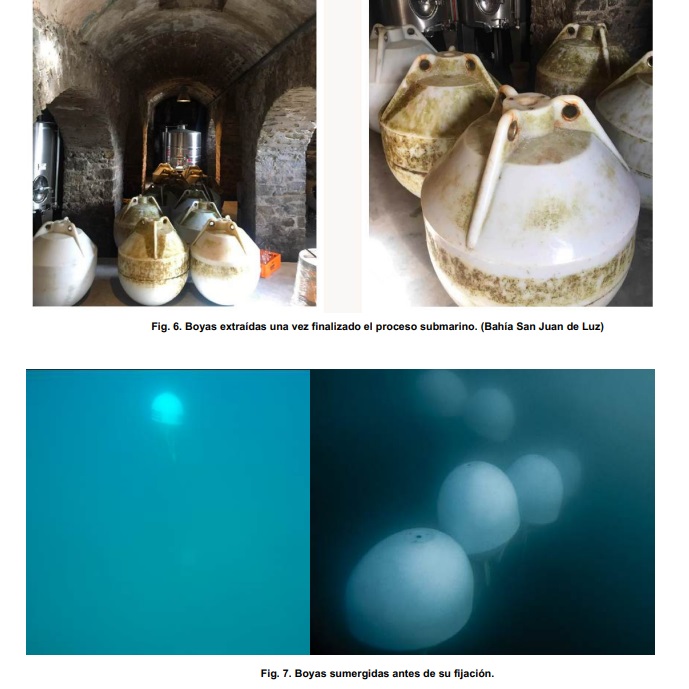A company plans to implement an innovative initiative in the waters of Ibiza: fermenting wine under the sea in front of Cala Roja with submerged buoys. For this reason, the Conselleria del Mar y Ciclo del Agua of the Balearic Government initiated a process of “public information on a request for authorization in the maritime-terrestrial public domain area for the installation of 15 underwater buoys storing wine inside”.
The application of the company Bodegas BH SL -known as Bodegas Habla- has been published this Tuesday in the Official Gazette of the Balearic Islands (BOIB).
“During a period of twenty working days, counting from the day following the publication of this announcement in the Official Gazette of the Islands, the project may be consulted on the web and may be submitted in writing to the Directorate General of Coasts and Coast, the allegations deemed appropriate,” it states.
The company, from the city of Trujillo in the province of Cáceres, defines itself as a company of “recognized prestige and professionalism, firmly consolidated in the wine sector for more than 25 years” and which is especially characterized “by its work in the vineyards with traditional and environmentally friendly techniques, together with constant research in the improvement of processes, sustainability and environmental integration”.
 Cala Roja, in the municipality of Sant Josep.
Cala Roja, in the municipality of Sant Josep.
Underwater fermentation
Bodegas BH intends to start next year the underwater fermentation of wine in the waters of Cala Roja, within the municipality of Sant Josep.
The proposal, currently in the public information phase, contemplates the installation of 15 watertight underwater buoys at a depth of at least 15 meters, using an “ecological” anchoring system designed to minimize the impact on the seabed.
The plan is planned to run for four annual campaigns, between 2026 and 2029, and each season the buoys would be anchored for four to five months and then removed, achieving “a high quality saline white wine, influenced by the pressure of the sea and its natural environment”.
How is the process
On its website, Bodegas BH claims to be “one of the most avant-garde winemaking projects in our country”.
“An unprecedented initiative that has positioned HABLA wines among the best wines in Spain,” he adds.
Now it wants to promote an innovative project in Ibiza which, according to the text presented to the General Directorate of Coasts, is part of an oenological research process that seeks to take advantage of the conditions of the underwater environment to modify the organoleptic properties of the wine.
“Habla del Mar Ibiza, the name of the wine, is an innovative project that fuses oenology with marine conservation. Through the immersion of the Habla del Mar wine, in tanks submerged 15 meters deep in the crystal clear waters of Ibiza, for a period of 4 to 5 months, we achieve a high quality saline white wine, influenced by the pressure of the sea and its natural environment,” he explains.
 This is what a wine matured under the sea would look like
This is what a wine matured under the sea would look like
This project “not only represents an advance in winemaking, but is also integrated into a strategy of sustainability and conservation of the marine ecosystem,” according to the document.
This technique is based on exposing the wine to an environment of constant pressure, darkness, stable temperature and micro-movement of the sea, conditions impossible to replicate in terrestrial cellars.
This underwater maturation is intended to “enhance its saline properties and freshness”, in addition to achieving a “differentiating oenological proposal in the premium wine market”, according to the document in the possession of La Voz de Ibiza.
In addition, they argue that this fermentation system is “proven and patented, as well as being currently being carried out in other locations for years, such as in the Cantabrian Sea”.
“Through this process, unique organoleptic qualities are developed in the morphology of the wine. On the other hand, the aromas of seaweed and saline and vegetal notes, typical of the local marine flora and fauna, confer the final result”, they emphasize.
In this line, they qualify the marine fermentation of wine as “a unique process whose differential factors, that is, the special and unique circumstances that the seabed provides to the fermentation process of such food are:
Temperature: the seabed on which the application is made offers unique conditions by allowing fermentation activity to occur under small but continuous temperature changes.
PressureThe seabed on which the application is made offers a pressure of approximately 3 atmospheres. The seabed on which the application is formulated offers a pressure of approximately 3 atmospheres.
MovementThe fermentation process: offers a unique rocking element based on its currents, tides and waves. This constant rocking movement of the fermenting food gives it special and unique characteristics.
Lower gravityThe weight of the object on the seabed is lower than on the surface, resulting in a higher gravity pressure that subjects the wine fermentation process, as food, to unique and only reproducible processes under the seabed.
TidesTidal biodynamics has a unique influence on the fermentation process of wine as a health food by increasing or decreasing the pressure exerted on it with a unique effect provided by the sea.
Why Cala Roja
The choice of Cala Roja as a dive site is not accidental. The promoter justifies the location by its logistical proximity and, above all, by the conditions of the seabed.
“This location has been chosen strategically, as it has a sandy bottom in its entirety, and does not affect any species of marine flora or fauna, as it is outside the scope of any area catalogued as an environmental space or of special interest,” the document details.
 The sandy bottom studied by the promoter
The sandy bottom studied by the promoter
On the other hand, the requested location “does not interfere with other activities, such as boat anchorages, commercial or recreational traffic channels, trawling, etc. It is also located away from the most common and frequent traffic routes”.
The sea conditions, in terms of waves and storms with strong winds, are also “favorable, being an area within the shelter offered by the Bay of Sant Antoni de Portmany”.
 A total of 15 buoys would be installed.
A total of 15 buoys would be installed.
This is how the buoy system will work
The core of the project are 15 watertight buoys, designed specifically for this use, which will be arranged in a grid of 4 meters by 8 meters, with a separation of 2 meters between units.
The complex will occupy a total area of 32 m² on the seabed, at 15 meters free depth, attached to the sandy substrate by means of ecological anchors. It will be able to hold up to 300 liters of wine.
“A maximum production of 270 final liters per buoy installed is estimated. This means a total maximum production of 4,050 liters per year,” he estimates.
The buoy “has a safety lock, which completely guarantees its hermetic state during the whole process. Likewise, they can only be opened by means of a special key specifically designed for the buoys proposed,” they explain.
These structures will not have positive buoyancy: they will remain on the bottom thanks to their weight and anchoring system, which prevents any drifting or displacement by currents.
 The buoys where the wine would ferment
The buoys where the wine would ferment
“Given that a sandy bottom has been selected in its entirety, and this system of propeller-type ecological anchors is proposed, it should be noted that the proposed system will not affect the environment at all,” the promoters maintain.
In addition, they are completely “disassembled and removed once the immersion of each season is over, thus ensuring the safety of the installation and the non-affection to the natural environment”.
The “first” in the Mediterranean
The company explains that “it has similar installations in other locations, all of which have been successfully executed and developed”.
He has also shown “special interest in this proposal, as it is the first to be carried out in the Mediterranean Sea”.
Although there are already underwater wine projects in different areas of the Mediterranean -such as wineries using cages, fixed cellars or submerged containers in Alicante, Liguria or the Croatian coast- the initiative presented in Ibiza introduces a different method: fermentation in these special capsules.
In this case, no bottles or permanent structures are used, but rather hermetic capsules integrated into submerged buoys, a temporary system that is removed every year and allows large volumes of wine to be stored in each unit.

The benefits of the project according to the developer
Continue reading:
Automatic Translation Notice: This text has been automatically translated from Spanish. It may contain inaccuracies or misinterpretations. We appreciate your understanding and invite you to consult the original version for greater accuracy.


Dining and Cooking